mercredi, 24 janvier 2018
De la nouvelle doctrine militaire américaine: la Russie et la Chine comme “menace croissante”

De la nouvelle doctrine militaire américaine: la Russie et la Chine comme “menace croissante”
Ex: http://www.zuerst.de
New York: La nouvelle stratégie militaire américaine a suscité, comme il fallait s’y attendre, la réprobation de la Russie et de la Chine. Le ministre russe des affaires étrangères Lavrov a déclaré lors d’une conférence de l’ONU à New York qu’il est désolant de voir que les Etats-Unis cherchent sans cesse à prouver leur capacité à exercer leur leadership en jouant la carte de la confrontation et non celle du dialogue et du droit international. La Russie, elle, en revanche, est prête à entamer un dialogue sur les doctrines militaires.
L’ambassade de Chine aux Etats-Unis a déclaré pour sa part que le gouvernement de Beijing s’efforcerait toujours de promouvoir « un partenariat global » et non d’asseoir une « domination globale ». Ceux qui observent le monde avec le regard de la guerre froide ne voient partout que conflits et confrontations.
Le ministre américain de la défense, Jim Mattis, avait en effet annoncé que les forces armées américaines se concentreraient désormais davantage sur la Russie et la Chine, après une décennie et demie de lutte anti-terroriste. Ces deux Etats, aux yeux du ministre américain, constituent une menace croissante et entendent organiser un monde fonctionnant selon leurs modèles autoritaires, a dit Mattis à l’occasion de la publication du texte révélant la nouvelle stratégie. Dans ce document de onze pages, les responsables américains mettent en exergue les priorités de la politique de défense de Washington.
Les autres “priorités” de la nouvelle doctrine de sécurité américaine sont la Corée du Nord et le renforcement de l’OTAN. Les pays partenaires doivent remplir leurs obligations et augmenter leurs budgets d’armement .
17:27 Publié dans Actualité, Géopolitique | Lien permanent | Commentaires (0) | Tags : russie, chine, états-unis, guerre froide, défense américaine, politique internationale, géopolitique |  |
|  del.icio.us |
del.icio.us |  |
|  Digg |
Digg | ![]() Facebook
Facebook
Un ancien ambassadeur britannique le révèle : les Etats-Unis veulent déstabiliser la Syrie sur le long terme

Un ancien ambassadeur britannique le révèle : les Etats-Unis veulent déstabiliser la Syrie sur le long terme
Ex: http://www.zuerst.de
Londres : Le ministre américain des affaires étrangères Rex Tillerson a annoncé officiellement, il y a quelques jours, que les Etats-Unis demeureront militairement actifs en Syrie dans l’avenir. Cette décision enfreint le droit des gens de plein fouet. L’ancien ambassadeur britannique à Damas, Peter Ford, vient d’accorder un entretien d’une grande clarté au portail russe « Sputnik ». Il y explique les raisons de cette volonté.
Les Etats-Unis n’ont pas l’intention d’introduire la démocratie en Syrie ni de détruire la milice terroriste du dit « Etat islamique ». Le plan de Washington vise bien plutôt à réduire à néant « toute stabilisation de la Syrie en tant qu’Etat unifié et souverain », a précisé Sir Peter Ford. « Depuis déjà quarante ans, c’est le but à long terme des Etats-Unis et ils ont aujourd’hui un début de chance d’atteindre cet objectif, en favorisant la naissance d’un Etat kurde dans le Nord et le Nord-Est de la Syrie ».
Le ministre des affaires étrangères Tillerson a esquissé les objectifs de la politique américaine au Proche Orient, sans trop de circonlocutions verbales. Ford : “Parce que les Américains ont vu, désormais, qu’ils ne pourront plus imposer par la force un changement de régime, ils cherchent dorénavant à saisir d’autres opportunités de déstabiliser durablement le pays”.
L’ancien ambassadeur britannique ne laisse planer aucun doute sur l’illégalité de l’intervention américaine en Syrie : « Ce que les Etats-Unis font là-bas est contraire au droit international. Entretenir une présence militaire de longue durée sur le territoire d’un Etat membre des Nations-Unies, est en contravention flagrante avec le droit des gens. Sans l’autorisation particulière et exceptionnelle d’un Etat, une telle présence est absolument contraire au droit ». Mais, ajoute Ford : « Les Etats-Unis jouent le jeu en appliquant d’autres règles et pensent détenir le droit de faire usage de violence. L’Amérique foule aux pieds le droit et la loi. On s’en aperçoit en maintes régions de la planète, pas seulement en Syrie ».
17:22 Publié dans Actualité, Géopolitique | Lien permanent | Commentaires (0) | Tags : actualité, géopolitique, politique internationale, syrie, proche orient, droit international, droit des gens |  |
|  del.icio.us |
del.icio.us |  |
|  Digg |
Digg | ![]() Facebook
Facebook
Le McCarthysme avant McCarthy
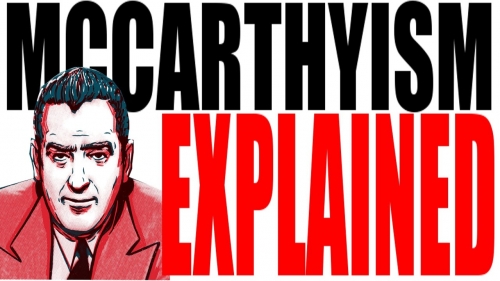
Le McCarthysme avant McCarthy
Ex: http://www.dedefensa.org
Justin Raimondo est un vieux briscard libertarien, ennemi de l’État centralisateur, pacifiste et antiguerre, isolationniste. (C’est aussi un homme malade qui lutte contre le cancer comme il en a avisé ses lecteurs, et qui poursuit avec héroïsme, sans faillir, sa mission de commentateur de la Grande Crise de l’américanisme. S’il faut symboliquement marquer la tradition des vœux pour une nouvelle année, qu’il en soit le récipiendaire.)
L’une des cibles privilégiées de Raimondo, outre les neocons, c’est la gauche moraliste et hypocrite, et hypocrite parce que belliciste sous couvert de moralisme, – ou de moraline, selon le mot nietzschéen. Cette fois (le 29 décembre 2017), Raimondo s’adresse à ces commentateurs de gauche honorables qui, en accord avec leurs idées, s’opposent avec vigueur et alacrité à la politique belliciste générale (la “politiqueSystème”, pour notre cas), et s’étonnent aujourd’hui, se scandalisent même, souvent avec fureur, de voir les démocrates et une bonne partie de la gauche progressiste US à la pointe du bellicisme et des simulacres qui vont avec, et essentiellement le Russiagate à cet égard ; et notamment, cette gauche “progressiste-belliciste”, instigatrice de la nouvelle vague de McCarthysme qui touche les USA à l’encontre de tous ceux qui ne vouent pas la Russie aux gémonies jusqu’à menacer ce pays de rien moins qu’un état de guerre à peine déguisé. Ces commentateurs de gauche honorables, ce sont des gens comme Glenn Greenwald de The Intercept ou Robert Parry de ConsortiumNews.
Raimondo est bien sûr de leur côté dans leur bataille antiguerre et leur dénonciation des progressistes-bellicistes, mais il tient, dans la chronique que nous citons, à leur rappeler ou à leur apprendre s’ils ne le savent pas que les pratiques McCarthystes qu’ils dénoncent viennent de bien avant McCarthy et que les premiers inspirateurs et organisateurs de l’appareil répressif qui permit le McCarthysme, c’est justement ceux de la gauche américaniste, communistes en tête. La boucle est bouclée alors, du marxisme-policier au marxisme-culturel... Quant aux neocons, ils ont retrouvé leurs origines naturelles, venus du trotskisme et installés au cœur du parti démocrate jusqu’aux années 1970.
Voici donc l’explication historique que Raimondo adresse aux “commentateurs de gauche honorables”...
« L’histoire se répète dans ce cas d'une manière bizarrement invertie : les neocons ont leur ascendance idéologique dans la faction belliciste et pro-sioniste du parti démocrate réunie autour du sénateur de l’État de Washington Scoop Jackson. Ils ont été écartés de la direction du parti à cause de leur engagement en faveur du conflit vietnamien que les démocrates rejetaient radicalement [à partir de 1969]. Aujourd’hui, ils retrouvent une nouvelle jeunesse dans leur parti d’origine grâce à une autre guerre, –contre Trump et contre Poutine.

Henry "Scoop" Jackson, Sénateur de Floride
» Les neocons ne sont nullement étrangers à l'art de la chasse aux sorcières mais les quelques [progressistes] actuels qui sont déconcertés par la prise de contrôle de “leur” parti démocrate par des menchéviks portant des œillères ne connaissent pas l’histoire. Le Hollywood libéral n’est pas avare d’interminables récits sur les “persécutions” infligées aux admirateurs de Staline par le Comité des activités anti-américaines de la Chambre (HUAC). Lorsque la HUAC tint des audiences pour enquêter sur des groupes communistes à l'hôtel de ville de San Francisco [à la fin des années 1940], les manifestants de gauche perturbèrent la procédure en manifestant leur sympathie pour les accusés. Ce dont on se souvient moins, si pas du tout, c’est que la première tentative d'établir un “contrôle de la subversion”, et en particulier par le biais de la HUAC, fut la “Brown Scare” une campagne menée par l'extrême gauche, avec les communistes à l’avant-garde. L’objectif de cette campagne était la soi-disant pénétration clandestine nazie aux USA, que le gouvernement devait extirper de vive force.
 » La HUAC avait été mise en place à la Chambre des Représentants en 1934 à la demande du député démocrate de New York Sam Dickstein (photo), qui devint plus tard un juge de la Cour suprême de l'Etat de New York. Il mourut en 1954. Après la dissolution de l’URSS et la chute du communisme, les archives du KGB ouvertes au public révélèrent que Dickstein avait été un agent rétribué des Soviétiques pendant des années. Dickstein manipula la HUAC pour faire passer les adversaires de Franklin Roosevelt pour des fascistes, et après l'invasion de la Russie par Hitler il essaya par tous les moyens d’assimiler le sentiment antiguerre aux USA au nazisme. Ses traitants des SR soviétiques lui avaient donné le nom de “Crook” [“Escroc”] en raison de sa cupidité exceptionnelle. Il avait insisté pour être payé l'équivalent de plus de $20.000 par mois par les Soviétiques.
» La HUAC avait été mise en place à la Chambre des Représentants en 1934 à la demande du député démocrate de New York Sam Dickstein (photo), qui devint plus tard un juge de la Cour suprême de l'Etat de New York. Il mourut en 1954. Après la dissolution de l’URSS et la chute du communisme, les archives du KGB ouvertes au public révélèrent que Dickstein avait été un agent rétribué des Soviétiques pendant des années. Dickstein manipula la HUAC pour faire passer les adversaires de Franklin Roosevelt pour des fascistes, et après l'invasion de la Russie par Hitler il essaya par tous les moyens d’assimiler le sentiment antiguerre aux USA au nazisme. Ses traitants des SR soviétiques lui avaient donné le nom de “Crook” [“Escroc”] en raison de sa cupidité exceptionnelle. Il avait insisté pour être payé l'équivalent de plus de $20.000 par mois par les Soviétiques.
» Le Parti communiste et les groupes “anti-fascistes” que le Parti manipulait étaient à l'avant-garde du mouvement pour réprimer la “subversion” pendant les années Roosevelt, et quand la guerre arriva les outils légaux étaient en place. Quant au président, il poussait continuellement son ministre de la justice Francis Biddle, à “faire quelque chose” contre “les isolationnistes”. Le “procès de la sédition“ de 1944 fut une farce totale, au cours de laquelle le ministère de la Justice tenta de prouver que les 30 accusés – du commentateur et auteur de The New Republic Lawrence Dennis à un certain Elmer J. Garner, un fermier populiste de 80 ans, militant anti-Roosevelt qui était trop sourd pour entendre un seul mot du procès et qui mourut quelques semaines après cette grotesquerie au cours de laquelle il avait comparu avec 32 cents en poche – s'étaient engagés dans une conspiration pour provoquer une mutinerie dans les forces armées alors que la plupart d’entre eux ne s’étaient jamais rencontrés.
» Les premières inculpations avaient été lancées en 1942, désignant un certain nombre de membres du Congrès et le Comité de l’association America First comptant 900 000 membres, ainsi que des groupes pro-allemands connus comme le Bund germano-américain. L’affaire se termina dans la confusion : lorsque le juge nommé au temps du New Deal mourut à la fin de 1944, le gouvernement décida de cesser les poursuites.
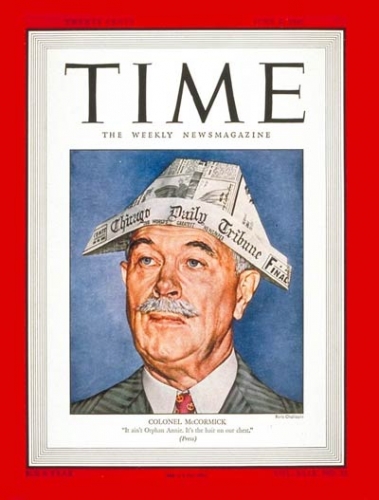 » Ce n'était que la plus visible des mesures répressives qui furent prises lors de la “Brown Scare” et qui furent ensuite réutilisées lors de la “Red Scare”. Il s’agissait d’un simple ajustement suivant le tournant de la politique étrangère américaine et un changement ultérieur de l'opinion publique américaine. Le FBI avait infiltré des groupes comme le Comité America First qui s'opposait à l'entrée des Etats-Unis dans la Seconde Guerre mondiale, il avait mis sur écoutes des dirigeants conservateurs tel que le directeur du Chicago Tribune Robert McCormick ; il suffisait alors de réorienter toutes ces procédures vers les cibles de gauche. Mais rappelez-vous l’essentiel : c’est la gauche qui lança tout cela et fit mettre en place la répression dans toute son ampleur, alors qu’elle tenait le fouet.
» Ce n'était que la plus visible des mesures répressives qui furent prises lors de la “Brown Scare” et qui furent ensuite réutilisées lors de la “Red Scare”. Il s’agissait d’un simple ajustement suivant le tournant de la politique étrangère américaine et un changement ultérieur de l'opinion publique américaine. Le FBI avait infiltré des groupes comme le Comité America First qui s'opposait à l'entrée des Etats-Unis dans la Seconde Guerre mondiale, il avait mis sur écoutes des dirigeants conservateurs tel que le directeur du Chicago Tribune Robert McCormick ; il suffisait alors de réorienter toutes ces procédures vers les cibles de gauche. Mais rappelez-vous l’essentiel : c’est la gauche qui lança tout cela et fit mettre en place la répression dans toute son ampleur, alors qu’elle tenait le fouet.
» Vous êtes donc surpris que nos “progressistes” montrent les dents et soutiennent avec enthousiasme les interminables enquêtes sur la “subversion” russe réalisées par un FBI très politisé ? Remettez-vous donc, – ils ne font que revenir à leurs vieilles pratiques historiques. »
Raimondo dit dans ces paragraphes beaucoup de choses intéressantes, qui ne sont pas inédites mais qu’en général on connaît peu ou très peu, et qu’en général on se garde le plus souvent de trop détailler lorsqu’on en connaît effectivement. Pour notre part, nous ne connaissions pas tous les aspects que détaille Raimondo, dans ce cadre précis de la mise en place d’un appareil répressif d’État où travaillent côte-à-côté le Congrès et l’administration fédérale, principalement le ministère de la Justice (DoJ), principalement par l’intermédiaire de son bras armé qu’est le FBI. Cet appareil de répression est un phénomène systémique en soi qui n’existait pas auparavant et qui pose les premières pierres de la structure fondamentale de l’État de Sécurité Nationale (National Security State). La structure sera complètement en place avec la National Security Act de 1947, qui créait le département de la défense (réunion des ministères de la guerre et de la marine), une force aérienne indépendante (l’USAF), la CIA et le Conseil de Sécurité Nationale (National Security Council, ou NSC, sorte de “gouvernement de sécurité nationale” personnel du président).
Les vagues de “panique” (Scare) qui ont précédé, comme la Red Scare de 1919, avaient amené des réactions de répression, – dans le cas cité, contre le “péril rouge”, socialo-communiste et anarchiste, – mais sans instauration d’une réelle structure répressive comme ce fut le cas à partir de 1933-1934 (selon la description de Raimondo). Le paradoxe de l’événement est que cette structure se met en place d’abord contre le danger nazi alors que les USA sont en plein cœur de la Grande Dépression et que le principal danger, du point de vue de la direction américaniste, aurait dû être perçu comme venant de la gauche et du communisme. Il apparaît que la “Brown Scare” (“Panique Brune”, référence aux “chemises brunes” nazies) est d’abord l’exploitation politicienne, voulue par Roosevelt et exploitée par la gauche radicale, d’une crainte d’une menace fasciste de prise de pouvoir, comme on en voyait beaucoup en Europe à cette époque. Sur ce point, sans aucun doute Roosevelt et la gauche coopérèrent pour exploiter cet atout de communication et mettre en place ce qui devint effectivement une structure bureaucratique de répression, – servant aussi bien contre la gauche que contre la droite. L’on peut ainsi considérer l’interprétation de Raimondo comme fondée en estimant qu’il y avait une certaine imitation des structures de répression d’État comme en URSS sous la pression de la gauche radicale et communiste.
 (D’un autre côté, Roosevelt, qui était d’abord un politicien roué assez éloigné de l’image idéalisée qu’on en fit et qui persiste, s’opposait aux tentatives légales d’avancement trop affirmé de la gauche radicale, comme par exemple lorsqu’il sabota indirectement la campagne de l’écrivain Upton Sinclair et de son programme EPIC (End Poverty in California) pour devenir gouverneur de Californie en 1934. Roosevelt, qui restait constamment soutenu par Wall Street même contre des centres importants de la direction économique [par exemple, Henry Ford, ennemi acharné de Roosevelt et de Wall Street], reçut dans le cas de la Californie le soutien de tous les dirigeants des studios d’Hollywood qui levèrent des bandes et des milices pour saboter la campagne de Sinclair. Dans ce cas, Hollywood la gauchiste et la progressiste, – ceux qui se considèrent comme des créateurs et des artistes, des scénaristes aux acteurs, – était priée rudement de s’aligner au moins dans la neutralité, tandis que la direction des studios hollywoodiens jouait parfaitement le jeu du président et donc de l’américanisme.)
(D’un autre côté, Roosevelt, qui était d’abord un politicien roué assez éloigné de l’image idéalisée qu’on en fit et qui persiste, s’opposait aux tentatives légales d’avancement trop affirmé de la gauche radicale, comme par exemple lorsqu’il sabota indirectement la campagne de l’écrivain Upton Sinclair et de son programme EPIC (End Poverty in California) pour devenir gouverneur de Californie en 1934. Roosevelt, qui restait constamment soutenu par Wall Street même contre des centres importants de la direction économique [par exemple, Henry Ford, ennemi acharné de Roosevelt et de Wall Street], reçut dans le cas de la Californie le soutien de tous les dirigeants des studios d’Hollywood qui levèrent des bandes et des milices pour saboter la campagne de Sinclair. Dans ce cas, Hollywood la gauchiste et la progressiste, – ceux qui se considèrent comme des créateurs et des artistes, des scénaristes aux acteurs, – était priée rudement de s’aligner au moins dans la neutralité, tandis que la direction des studios hollywoodiens jouait parfaitement le jeu du président et donc de l’américanisme.)
... Car enfin, ce que nous suggère indirectement Raimondo en décrivant la mise en place de cette structure répressive commanditée par la gauche, c’est bien la description d’une branche de cet “État de Sécurité Nationale”, à peu près au même moment où le Complexe Militaro-Industriel allait commencer à prendre son élan. Roosevelt ayant installé un gouvernement très fort et très centralisé pour lutter contre la Grande Dépression, effectivement l’ensemble de la dynamique mise en place évoluait vers cette énorme infrastructure bureaucratique, à la fois de communication, de répression et de développement technologique, que l’on connaît aujourd’hui, – d’une certaine façon, le véritable DeepState qui est une sorte de Mordor des USA. De ce point de vue, McCarthy n’avait pas beaucoup d’effort d’organisation à faire pour lancer sa campagne anticommuniste en 1950 parce que l’outil existait ; plus encore, qui s’étonnerait d’apprendre qu’en se lançant en politique (élu sénateur en 1944), McCarthy était clairement à gauche et pro-Roosevelt, et qu’il ne devint anti-communiste que pour sa campagne de réélection dès 1950, ayant jugé l’anticommunisme comme un bon argument de communication.
Ainsi la mise en accusation de la gauche progressiste US par Raimondo est-elle fondée, et même plus grave encore qu’une simple “passade” pour souligner un événement conjoncturel. Manipulée ou pas, la gauche progressiste a largement participé à la mise en place structurelle de certaines fondations du monstre bureaucratique, répressif et belliciste, que sont devenus les USA, et son évolution actuelle n’est rien d’autre qu’un retour à l’envoyeur, ou l’achèvement d’une “révolution” dans le sens originel sur lequel insiste Hanna Arendt (une révolution est d’abord une ellipse d’un corps dans l’espace, le ramenant à son terme à son point de départ). Quoi qu’elle en dise, la gauche progressiste US regarde le McCarthysme comme l’on se regarde dans un miroir. Dont acte, et suffisamment pour avoir toute confirmation que l’américanisme, c’est-à-dire le cœur grondant du Système, n’épargne aucune vertu, surtout parmi ceux qui prétendent en faire leur production exclusive.
01:03 Publié dans Histoire | Lien permanent | Commentaires (0) | Tags : histoire, états-unis, censure, répression, maccarthysme |  |
|  del.icio.us |
del.icio.us |  |
|  Digg |
Digg | ![]() Facebook
Facebook
The Russo-Chinese "Alliance" Revisited
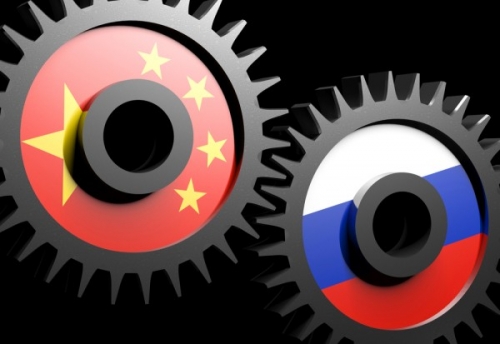
America’s greatest strategic mind of global recognition, Alfred Thayer Mahan, in his seminal work The Influence of Sea Power upon History saw the World Ocean and activity in it as the foundation for national greatness and power. The pivot of this greatness was a powerful navy. Through Mahan, the Theory of Navalism reached American elites late in 19th Century. As Byron King noted:
Mahan’s book struck the highest levels of the governing classes like a bolt of lightning and created a tempest of intellectual upheaval not just within the U.S. Navy, but throughout the broader American (and overseas) political, economic, and industrial system.
It was, however, not Navalism as a theory which contributed to both intellectual and, eventually, social upheaval—it was the industrial revolution and the technological paradigm that revolution created, which propelled ideas of naval blockades and of the decisive battles of large fleets to the forefront of global strategic thought. The confirmation of the correctness of Mahan’s vision didn’t have to wait for too long—on 28 May 1905, in the straits of Tsushima, Russia’s Baltic Sea Squadron of Admiral Zinovyi Rozhesvensky was almost completely obliterated by the Japanese naval force of Admiral Togo in what amounted to one of the most lop-sided battles in history. Russia’s de jure defeat in the Russo-Japanese War of 1904-05 became inevitable in the wake of Tsushima, which became in Russia a euphemism for a catastrophe. Recriminations and, eventually the First Russian Revolution followed as the result of this military-political humiliation. This outcome also cemented a central postulate of Navalism—large, expensive fleets became the main force which embodied both national prestige and safety for the trade of the nation which possessed them. The era of battleships and cruisers unfolded but so did the era of submarines.
The explosive technological and doctrinal development of fleets, both naval and commercial, followed. Also Mahan’s ideas that the old concept of Guerre’ de Course, of commerce raiding, simultaneously matured and reached industrial proportions, which would see massive naval battles on the Shipping Lanes of Communications (SLOC) during WW I and, especially so, during WW II. The Safety of SLOCs and maritime Choke Points became defining factors in Western strategic thinking of the 20th Century. Nowhere was this more so than in Great Britain and, especially, in the newly emerging superpower of the United States. The World Island is how Admiral Elmo Zumwalt defined the United States of the 20th Century. The post WW II US Navy became more than just a concentrated material expression of American national pride and of industrial-technological prowess; it became the guarantor of the safety of those numerous SLOCs and Choke Points on which American prosperity depended then and continues to depend even more so today.
Enter the 21st Century. With the collapse of the Soviet Union, the US Navy lost its only modern peer—the Soviet Navy. Today, the US Navy reigns supreme over the vast spaces of the World Ocean, thus making American maritime trade secure. For now it also controls the world’s maritime trade which amounts to almost 90 percent of all global trade. A fleet of more than 62 000 commercial vessels every day carries millions tons of cargo, ranging from crude oil and ore to washing machines and cars, between hundreds of ports, thus generating trillions of dollars in capital movement every month. It seems that the United States with her magnificent navy is living proof of the old geopolitical truism that the one who controls the World Ocean controls the world’s trade, and thus controls the World. This was true with the United States being the most productive and largest industrial economy in the post-World War Two world. This is not the case anymore. To be sure, the United States still hugely depends on and still controls most SLOCs, but this time the pattern is different and is changing constantly.
China’s ever-growing manufacturing capacity entered the game—the times when the United States was shipping massive amounts of finished goods and of materiel both to Europe and elsewhere around the world are over. Of course, the United States still produces many finished goods, some of them of a world-class quality, such as commercial aircraft, processors, generators, and engines, to name just a few; but in 2017 the United States posted an astonishing 344 billion dollars trade deficit with China. Today, the US controlled SLOCs in the Asia-Pacific area operate as supply lines for the US internal market, shipping monthly tens of billions of dollars’ worth of the finished consumer goods to the United States, filling the shelves of American Walmarts, Targets and Costcos with mostly Chinese-manufactured TVs, home appliances, computers, Smart phones, furniture, and articles of clothing. The United States today depends on China for its own everyday consumer needs. This dependence is unprecedented historically and is a powerful reason for questioning both America’s internal and international trade policies. Today, trade deficits of such a scale are among the most important drivers behind contemporary geopolitical upheaval.
The United States is in a trade hole and that hole is extremely deep. Yet, while the US-Chinese trade is the talk of the town and is extremely important in explaining contemporary geopolitical dynamics, and an inevitable US-Chinese trade war, a much larger but less talked about global scenario is beginning to emerge and it has everything to do with the fact of China’s (One) Belt and Road initiative aka the New Silk Road. A lot has been said about this massive project, most of it is positive and it is derived from the fact of the seemingly much fairer and beneficial, for all parties involved, nature of it. This is true, especially against the background of the mayhem and destruction the United States has unleashed around the world. Yet, the Chinese project is far more than just an exercise in charity which it certainly is not. China, with her excessive industrial capacity, is in it for a much bigger prize than the United States, with its sluggish consumer market and declining standard of living. Nor are Africa or Eurasian subcontinent the targets, although often placed in the center of Chinese considerations. The name of the Chinese game is Europe. Without Europe, the One Belt and Road initiative becomes merely an expansion into large but mostly poor markets in Asia. The Philippines or Indonesia cannot compare to the advanced economies of Germany or France. Europe, not just the EU, is a different game. With her almost 750 million population and a GDP larger than that of China or the US, Europe is the only truly wealthy market left in the world. China desperately needs access to this market both through the land bridge and SLOCs and it is here where the geopolitical dance of the century becomes extremely intricate. Several important facts must be considered before drawing any conclusions on the mid to long-term developments:
1. The United Stated posts huge trade deficits not only with China. The US is in a deep 56 billion dollars trade hole with Germany in 2017. It consistently posts trade deficits with most European nations from France to Finland and Russia. With the EU alone, the US trade deficit is more than 135 billion dollars. With the exception of military hardware, commercial aircraft and some electronics, the US is simply not competitive in Europe. China is and precisely in that sector where the United States produces next to nothing—consumer goods. The Europeans are aware of this, as they are apprehensive of China’s One Belt and Road. Speaking on January 10, 2018 France’s President Macron was explicit in his description of the Silk Road:
“We must come up with a common position at the European level…We can’t disregard this initiative. It would mean dealing with its consequences and would be a profound strategic mistake.”
Europe does feel a need to protect her strategic sectors and those are the ones where China still lags considerably—the high-tech machine building sectors.
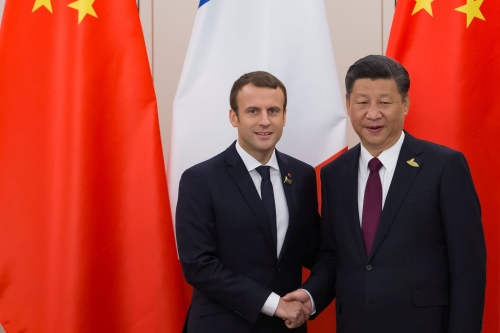
2. With China securing the safety of her strategic rear and crucial resources by entering into all but an full-fledged military-political alliance with Russia, China seems poised to complete the Silk Road’s land-bridge, a small part of which will go through Russia. Modern transportation technologies, including high-speed rail—the exact field in which China is one of the global leaders—may significantly change the matrix of goods’ flow and, indeed, interconnect Eurasia with a highly developed railroad network. In fact, the work is already in progress. But here is the catch.
3. Commercial marine transport still remains the most efficient way of delivering large quantities of goods—a term “Road” stands for SLOCs in a One Belt and Road initiative. China needs this Road which connects her ports with the Mediterranean and it is here where all illusions about this Chinese initiative must be dispelled.
There is a lot of talk about the Russia-Chinese alliance, as well as about Russia being a junior partner in such an alliance. All this is a result of not seeing the very serious real factors behind the new Silk Road. First, China’s initiative is not that beneficial to Russia. In fact, it goes contrary to Russia’s own plans for creating a new Eurasian Economic Union (EAEU). Russia has its own designs on large portions of the markets China sees as her own. Russia, dominating Eurasia’s heartland, has a shot at a serious upgrade of its own role in this plan and that is what Russia is doing already. One of the major reasons is the fact that the US Navy and the Chinese Navy (PLAN) are simply in different leagues. One may say, and justly so, a lot of negative things about the US Navy, which does face a whole host of large technological and operational problems, but there can be no denial that it still remains the most powerful naval force in history. It is precisely this force which can, if push comes to shove, stop any maritime trade in almost any part of the world. The “almost” qualifier is extremely important here.
One also may say that this is an unrealistic scenario, while in reality it is anything but. The Chinese Navy (PLAN) was in construction overdrive for a decade now and it built a large number of surface combat ships, some of which on paper look impressive. By 2030 it also plans to have four aircraft carriers in its order of battle. China is also building naval bases in Pakistan, which is prudent once one considers that a large portion of this “Road” passing through the Indian Ocean. But the question remains—in the case of an inevitable US-China trade war, which may go hot on “neutral” territory, will the Chinese Navy (PLAN) be able to defend its SLOCs from the interdiction by the US Navy?

The answer is an unequivocal no. China may already have a very serious A2/AD (Anti-Access/Area Denial) capability which would deters the US Navy and make its life difficult in the South China Sea, but blue water operations are a completely different game. The US Navy today and in the foreseeable future has an ace up its sleeve, and that is a world-class, massive nuclear attack submarine force which, considering the US Navy’s powerful surface element, will not allow PLAN to defend its SLOCs. While Mahan’s ideas seem to be moribund, they may yet see their resurrection in the form of a large fleet standoff with global implications.Neither now nor in the foreseeable future will China be able to overcome the US Navy’s technological underwater superiority, and eventually the Chinese will also need to contend with India’s view of the Indian Ocean as her own internal lake. India also sees the Chinese naval presence in the Indian Ocean as a threat to herself. It is not surprising therefore to see increased cooperation between the US and Indian Navies. The PLAN is not ready to face such odds, especially when one considers the rather unimpressive technological reality of PLAN’s submarine force—this inferiority in technology and numbers will not be overcome any time soon. In plain language, in the open ocean the US Navy can and, most likely, will sink the Chinese Navy and that will mean the end of the Road, leaving onl the Belt to China.
In the end, the United States also needs Europe in a desperate attempt to revitalize own economy by utilizing the subjugated and split EU as the main market for US hydrocarbons and goods. The US doesn’t need Chinese competition in what has now become a struggle with enormously high stakes for the United States. After all, the memories of America as a global industrial powerhouse are still fresh among many. This, eventually, may move the United States into full confrontational mode with China and it is here where Russia will have her own very appealing strategic fork in the road, with some preparations for this fork now being made. The most important sign of this was Vladimir Putin’s rather startling revelation, during his October 2017 Valdai Forum conversation with youth, of his concern for the fate of white European Christian Civilization and his desire to preserve it.
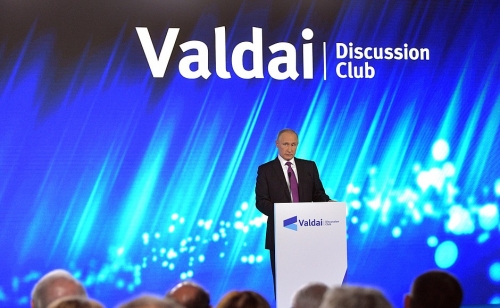
The importance of this statement is difficult to overstate—much more is at stake than mere economic issues, however important. The Russian-Chinese alliance today seems unshakable and it will remain so for a while, but, contrary to some opinions, this is not because Russia needs China—certainly no more than China needs Russia. It is a situational global alliance, but it is also the economically natural alliance of two very close neighbors. China needs Russia’s resources, which Russia gladly sells to China, but China also needs Russia’s technology and she needs it desperately. Europe is also not just a market for China; it provides access to very advanced technologies, from nuclear power to transportation. But Europe and Russia are effectively the same culture, while China and Russia are not.
Putin at Valdai confirmed Russia as primarily a European nation and stressed the necessity to preserve it as such while preserving European, which is Western, culture as a whole—this is without doubt a most startling and profound political statement from a major global statesman in the 21st century. Preserving European culture is impossible without extremely advanced technology and advanced military systems, but that is what Russia has been building for the last decade. With Europe slowly coming to some understanding of the dead end of its cultural and economic policies, it is becoming clear that Europe sees neither China nor the United States as friends. Yet, even despite sanctions on Russia, the Q3 2017 reports saw a very significant, double digit, growth in trade between Russia and Germany, Netherlands, Italy, and Austria—hardly a sign of an isolated nation. The trade with China also grew tremendously by more than 20% and reached 84 billion dollars, with a target of 200 billion to be reached in the nearest future. There will be no cohesion to any Eurasian economic plans without Russia. The Russians know this, and so do the Chinese and the Americans.
More importantly, while it is primarily Russian or Russia-derived military technology which has already firmly secured the Chinese and Russian littorals and their near sea zones from any aggression, Russia holds yet another joker up her sleeve. It is the Northern Sea Route, which China supports enthusiastically. She has sound reasons for doing that. Unlike the Indian Ocean where PLAN would have to face the immensely powerful US Navy, Russia controls the Arctic and possesses a world-class A2/AD capability there, from advanced nuclear submarines, patrol and missile carrying aviation to a system of surveillance and reconnaissance sensors and coastal weapons, which make this route a desirable trade artery, also being much shorter than other maritime routes. The pace of Russian construction of ice-breakers for year-round operation of this ice route, now greatly mitigated by climate change, testifies to the fact that this route is already becoming an important economic and geopolitical factor.
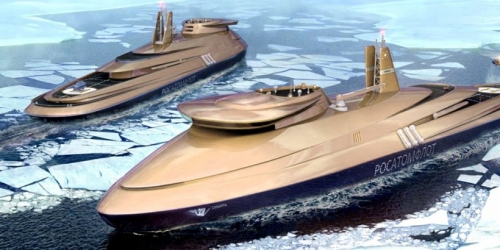
The strategic implications are enormous—neither the US Navy, nor, for that matter any other navy, would be able to interdict Arctic SLOCs. Russia already has enough fire-power in the Arctic to ensure that passage is peaceful under any geopolitical conditions, while retaining, if need be, the capacity to shut it down. China has no such capabilities. But that is why China knows how to behave with Russia, which is also, together with Finland, a source of advanced technology for China not only militarily but for the use of this route. As The Diplomat noted:
In short, as long as solid Russia-China relations exist, the future of the Ice Silk Road is bright.
There are no reasons for China or Russia to spoil their relations, especially now when the agreement has been signed and a JV established for developing and building Russian-Chinese long-range wide-body CR 929 aircraft, which gives China access to world-class Russia’s commercial aircraft design and technologies. Russian-Chinese energy and infrastructure projects are also impressive and have huge potential for growth. In general, after all of these factors are considered, one can easily see that no matter how one plays with numbers or geography, Russia long ago secured both continental and maritime pivot positions for any major Eurasian project. She did that by playing to her many strengths. Then, by openly stating her European cultural roots, Russia has asserted her claim to be the very real bridge between Asia and Europe and she has all the necessary economic, technological and military wherewithal to support such a claim.
Will Europe get the signal? There are certainly many there who got it already but so did the United States, whose neocon cabal is going apoplectic when facing an unfolding geopolitical reality in which the United States may be simply bypassed as a player in Eurasia or, under highly desirable yet unattainable conditions, see herself reinventing herself as a major global productive player. How to do this? Alfred Thayer Mahan left no instructions and that could be a big problem. But if we all manage to avoid Mahan’s vision of large fleets blowing each-other out of the water with modern conventional let alone nuclear weapons, in their desperate fight to control shipping lanes of communications—this, I think, will fit the common sense of most people in Russia, the US, China and Europe. These four players must sort their problems out in a peaceful and civilized way—there is no other viable option. The only alternative is a bloody destructive triumph of Navalism.
01:00 Publié dans Actualité, Affaires européennes, Eurasisme, Géopolitique | Lien permanent | Commentaires (0) | Tags : politique internationale, géopolitique, actualité, route de la soie, chine, russie, états-unis, alfred mahan, flottes, europe, affaires européennes, asie, affaires asiatiques, économie, géoéconomie |  |
|  del.icio.us |
del.icio.us |  |
|  Digg |
Digg | ![]() Facebook
Facebook


